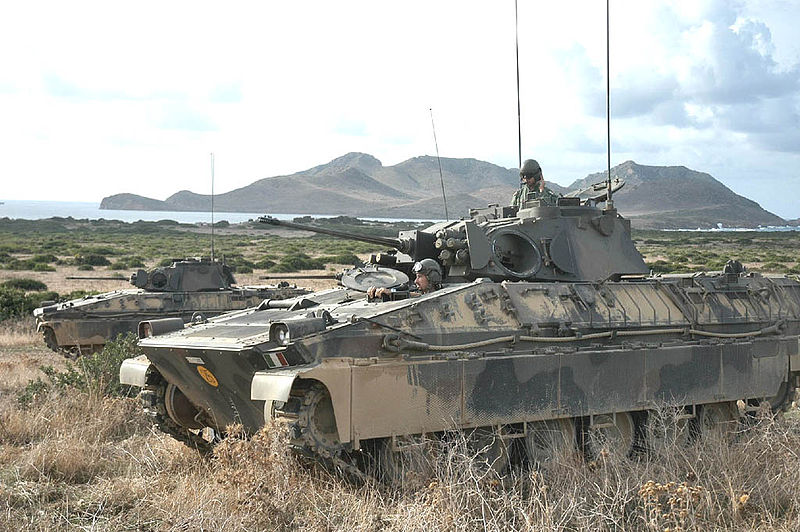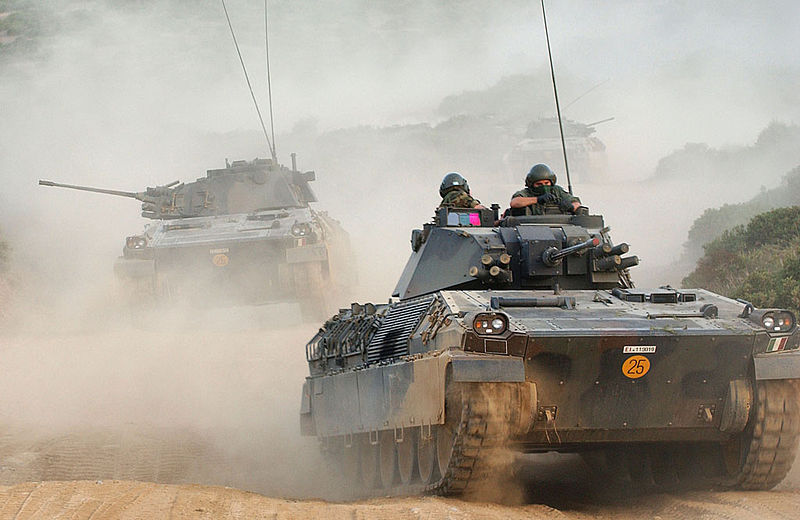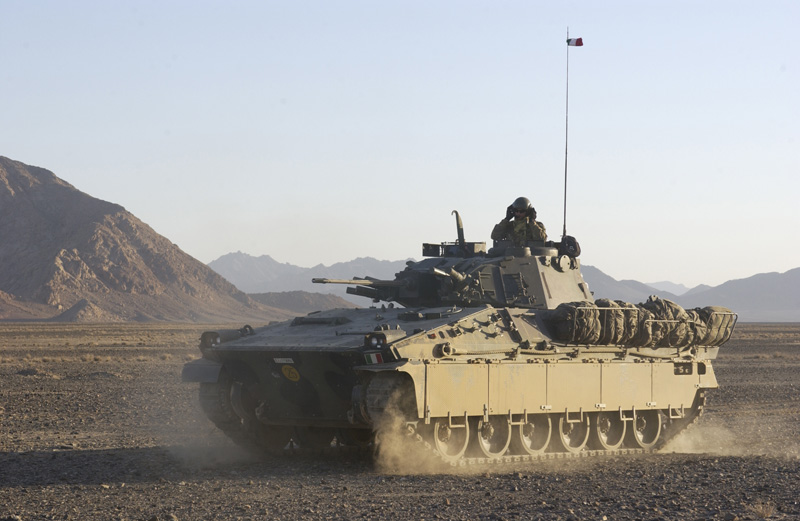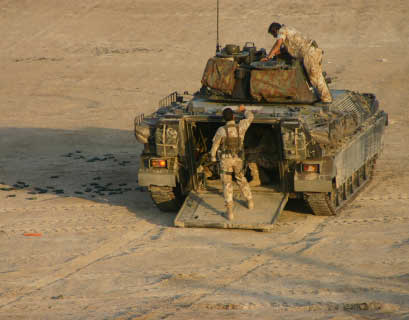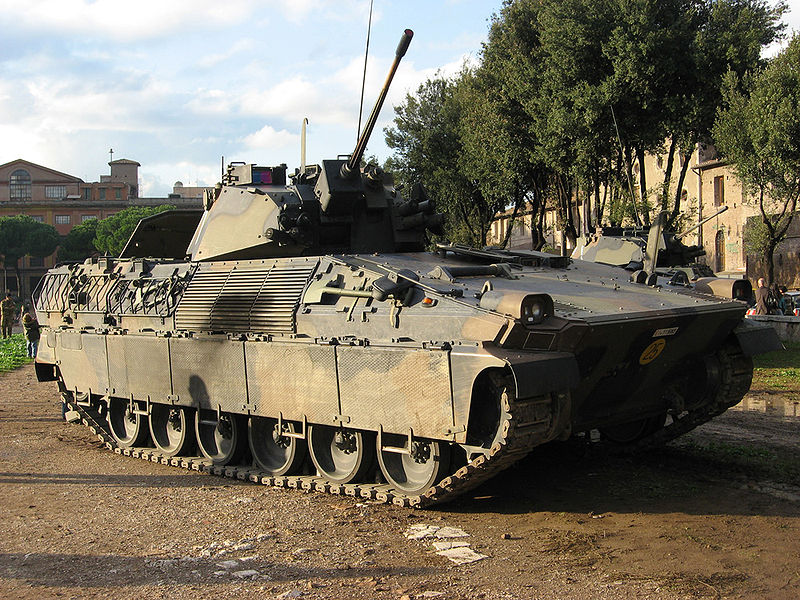The "Dart"
The Italian Dardo was designed to replace the M113 at large, and was inspired by modern IFVs like the Bradley and the Marder. Development started in the early 1990s by the industrial consortium Iveco Fiat Oto Melara. Iveco was in charge of the hull and powerplant while Oto Melara was responsible for the weapons, FCS and electronics.The first prototype was tested in 1996 and the production vehicle was ready by 1998 when it entered service, being accepted by the Army. Now 200 has been produced so far, given mostly to Bersaglieri units. Its wheeled equivalent is the Freccia IFV, a spin-off of the Centauro tank destroyer.
Design
A look on the Dardo is sufficient to tell its purpose, it is quite straightforward as an IFV, with all the typical characteristics of the type: A 20 mm autocannon complemented by AT missiles, a good armor, a rear crew compartment, and some speed to go with it. The hull is made of aluminum alloy, quite like the M113, but with add-on steel plates for a better protection. Although specs are not well known it is declared proof against 25 mm APDS rounds over the frontal arc while the sides are protected against 14.5 mm API rounds. In addition, for concealment (and alternative frag grenades), four 80mm grenade launchers are installed on each side of the front of the turret.The engine and transmission took place on the right-hand side, while the driver sat on the left. He has a sliding hatch with three vision blocks (central IR sight). The powerplant is an Iveco V6 turbo-charged after-cooled diesel, capable of 512 hp (382.2 kW), and coupled with an Iveco Fiat ZF type automatic transmission system with four forward/two reverse gears. It also incorporates the steering system and a hydraulic retarder.
The hull rests on a drivetrain composed of six rubber-clad roadwheels, and there are three return rollers on each side. The tracks are of the connector type, single pin. Drive sprockets are at the front, idlers at the rear, and the suspensions comprised torsion bar units, complete with a bumper and a hydraulic shock absorber. The braking system comprises discs on each of the final drives, governed by a transmission retarder. As measured in tests field, top speed is well above 70 km/h, with the governed top speed. It is capable of climbing 60% gradients and ford 1.5 m deep rivers without preparations.
The armament is concentrated in the two-man turret. The core is a 25 mm Oerlikon KBA automatic cannon, capable of 600 rpm, and fed with 200 ready rounds stored in the turret, with extra round stored in the hull. In addition, there is a coaxial 7.62mm NATO machine gun, and another one around the roof ring mount, served by the commander. The six infantry carried can, in addition, fire their personal weapons through two side pistol ports at the rear, plus one in the rear door. The larger defensive bubble (4,000 m) is provided by two Spike-LR ATGM in orientable containers each side of the turret are removable. The commander is seated on the left-hand side, provided with six episcope sights of a 360° field of view and panoramic stabilized sight.
The FCS (Fire control System) made by Galileo Avionica is the Hitfist integrated system capable of measuring target speed and range for accurate fire on the move. The gunner is given a laser range finder and thermal imager, but the commander can monitor the gunner's own night vision system.
Service
The Dardo was not exported yet. Active units are:- 1st and 8th Bersaglieri Regiments, Garibaldi Bersaglieri Brigade
- 11th Bersaglieri Regiment, Ariete Armored Brigade
- 1st Regiment Granatieri di Sardegna, Granatieri di Sardegna Mechanized Brigade
Links about the Dardo-AFV
The Dardo IFV on Wikipedia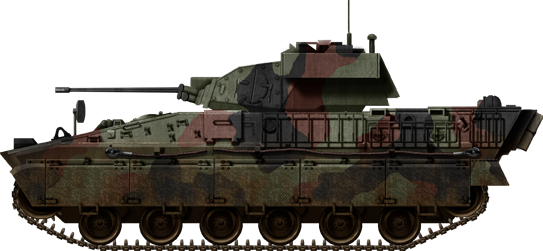
Dardo Infantry Fighting Vehicle as of today. Versions differed by heir hull slat armour/baskets arrangements.
Dardo IFV specifications |
|
| Dimensions | 6.7 x 3 x 2.64 m (22 x 9.8 x 8.6 ft) |
| Total weight, battle ready | 23.4 tons ( ibs) |
| Crew | 3 (driver, cdr, gunner) +6 troops |
| Propulsion | Iveco–Fiat 6V MTCA TD 512 hp (382.2 kW) P/w 24.5 hp/t |
| Suspension | Independent hydraulic torsion bars Units |
| Top Speed road/off-road | 70 km/h (43.5 mph) |
| Operational maximum range | 600 km (373 mi) |
| Armament | 25 mm Oerlikon (200 rds), 2x7.62 LMGs, 2xTOW ATGMs |
| Armor | Aluminium alloy + steel, 15-30 mm range. |
| Production | 200 so far |

